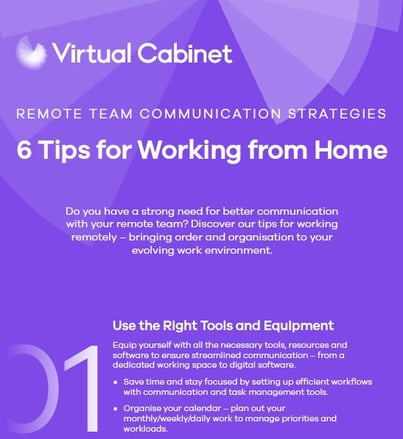Strategies to Promote Excellent Communication and Collaboration for Teams Working Remotely

Are you part of a remote working team? The key to success is communication. In the office, you have the freedom to wander over to your colleague’s desk to ask them a question, or get together in the meeting room for a collaborative session – but the communication needs and structure of a remote team are different. Adjusting to a remote working environment is still considered new for a lot of people, so managers and colleagues are now having to collaborate more than ever to ensure business runs as usual.
Whether you’re missing your whiteboards, or rely on in-person interactions to collaborate on tasks and get the job done, keeping your team working effectively and efficiently is a challenge that all remote businesses face.
Are you looking to streamline your workflows and guarantee quality staff output? Discover our tips for working remotely below.
Communication Tips for Remote Teams
Streamlined remote team communication is all about working smarter, not harder – and that’s where our tips for working remotely come in. From setting clear deadlines to investing in the right software, our free downloadable guide below talks you through the top communication tips for remote teams.
Remote Team Communication Strategies: Synchronous Vs. Asynchronous
Are you wondering how to make remote collaboration more effective? Take a look at your approach to communication. Synchronous communication involves two or more people working together in real-time – an approach that comes to you much more naturally in the office – which requires an immediate response. On the other hand, asynchronous communication involves intermittent responses and non-real-time interaction.
Your remote team communication strategies will likely involve elements of the two. If you work with colleagues in a different time zone to you, more of your communications will have to be asynchronous. Finding the perfect balance and ensuring you’re using the best communication tools for remote teams at all times isn't easy but it can be done.
When to Use Asynchronous Communication
Does your task or message require an immediate response, or is there time to spare? Asynchronous communication includes email, dashboards and various task management tools – ideal for announcements, large projects, ideation and unimportant feedback. This form of communication is ideal if you are continuously interrupted for immediate responses, as instead you can focus on the task at hand and consider your responses.
When to Use Synchronous Communication
Typically, synchronous communication is used in person at the office – from face-to-face meetings and nipping over to a colleague’s desk for a quick chat, to company trips and performance reviews. This method of communication is the ideal choice for social situations, team-building exercises and urgent requests. When it comes to remote team communication, the synchronous approach has been adopted through video calls (for internal and external meetings, as well as team socials) and instant internal chats.
How Would You Overcome Communication Challenges on a Remote Team?
Ultimately, your remote team communication strategies will adapt to your working style. With the right blend of synchronous and asynchronous communication, you can ensure that your team works effectively and efficiently. Here are a few tips for working remotely that will ensure a better connection within your teams, internally and externally:
- Set guidelines – from the tools that your business uses to working hours and meeting requirements.
- Set expectations for response times – take the pressure off needing immediate responses for everything.
- Be consistent – if you’re setting guidelines, make sure everyone follows them. And book in regular catch-ups to maintain contact and stay on track.
- Separate work and professional communication – it’s no secret that personal communication can distract you from your work, and detract from the professionalism within your team. So keep your communication tools for your personal and work life separate.
- Follow up – after video meetings or calls, make sure you follow up with meeting notes to ensure that everyone involved is aligned and working towards the same goals. Avoiding confusion will ensure a smoother process from start to finish.
The Best Communication Tools for Remote Teams
No one should be bombarded with messages from colleagues, taking them away from their work – and the best communication tools for remote teams help to prevent this. Bring order and organisation to your evolving work environment with Virtual Cabinet’s communication tool. Our cloud content management app is the ideal task tool for businesses of all sizes – taking you one step closer to missing less, forgetting less, chasing up less, and getting more done with clarity.
To understand how the Virtual Cabinet Document Management Software can help streamline your workflows and remote team communication strategies, book a free demo to speak to one of our experts. We’ll help you identify your pain points and provide a tailored solution to suit your business.
